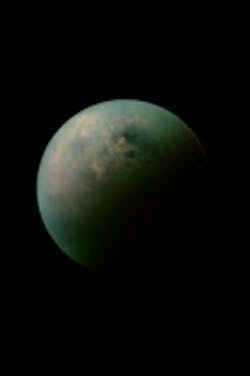Images captured by Cassini spacecraft may show ocean waves on Titan
NASA’sCassini spacecraft recently captured images that showed unusual glints of sunlight off the surface of an ocean—a potential indicator of the presence of waves—on Titan, Saturn’s largest moon, which would be the first discovery of ocean waves beyond Earth.
Unusual sparkles of sunlight were observed off the surface of Punga Mare, one of Titan’s hydrocarbon seas, in 2012 and 2013. In images captured by the Cassini aircraft’s visual and infrared mapping spectrometer (VIMS), four pixels in the images appear brighter from reflected sunlight. These reflections may come from tiny ripples no more than 2 cm high in the ocean, according to the journal Nature.
VIMS is acolor camera mounted on Cassini that captures images in 352 colors at the same time, with wavelengths between 300 and 5100 nm. The VIMS system contains a pair of imaging grating spectrometers designed to measure reflected and emitted radiation from atmospheres, rings, and surfaces over wavelengths from 0.35 to 5.1 µm:
- Visible channel (0.35 to 1.07 µm [96 channels]; 32x32 mrad field of view)
- Infrared channel (0.85 to 5.1 µm [256 channels]; 32x32 mrad field of view)
Light captured by the spectrometers is focused onto aCCD detector array of 256 x 512 elements that each count the number of photons they receive.
Researchers involved in this finding expect more waves to appear in the next few years due to the fact that winds are expected to pick up as Titan’s northern hemisphere (where most of its seas are located) emerges from winter and approaches spring.
"Titan may be beginning to stir," said Ralph Lorenz, a planetary scientist at the Johns Hopkins University Applied Physics Laboratory, in the press release. "Oceanography is no longer just an Earth science."
View thepress release
Also check out:
NASA telescope observes evidence of creation of the Universe
Hubble captures image of mysterious disintegrating asteroid
NASA’s Kepler spacecraft discovers 715 new planets
Share your vision-related news by contactingJames Carroll,Senior Web Editor, Vision Systems Design
To receive news like this in your inbox,click here.
Join ourLinkedIn group | Like us on Facebook | Follow us on Twitter| Check us out on Google +
About the Author

James Carroll
Former VSD Editor James Carroll joined the team 2013. Carroll covered machine vision and imaging from numerous angles, including application stories, industry news, market updates, and new products. In addition to writing and editing articles, Carroll managed the Innovators Awards program and webcasts.
